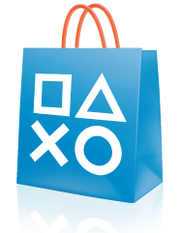
The PlayStation Network logo
The PlayStation Network (abbreviated PSN) is Sony's online multiplayer service for the PlayStation 3 and the PlayStation Portable (PSP). PSN was launched in November 2006 and as of June 23, 2009 there are over 25 million registered users.
Features[]
Sony's PlayStation Network was unveiled on May 15, 2006 during the PlayStation Business Conference. The service's features were announced at Sony's TGS 2006 press conference. Since its launch it has been updated with new features and services.[1]
User registration[]
Registration is performed via the PlayStation 3 console, a PlayStation Portable or a personal computer. Two types of accounts can be created; Master accounts and Sub accounts. Master accounts allow full access to all settings, including parental control, but the Master must be over the age of 18 to create an account. Sub accounts can subsequently be created with desired restrictions set by the master account holder.[2]
Since Master/Sub accounts are not linked to the PlayStation 3 serial number, which allows users to buy and sell used consoles, they can be used with different consoles as a guest user; therefore a single console can have multiple Master accounts. Although unregistered users can access and browse the PlayStation Store, registration is required to purchase items. Once purchased, items can be downloaded from the PlayStation Store to up to five consoles, however if the user account is removed from the console, the content becomes invalid and is locked.
PlayStation Network launched in November 2006 to coincide with the launch of the PlayStation 3 console in North America and Japan. Due to the delay of the European launch to March 2007, Sony allowed residents of Europe to pre-register their PlayStation Network via PC in order to reserve their favored PSN ID, allowing them to quickly retrieve their details on the day of release.[3]
Account[]
- User Registration of Master/Sub accounts
- Login ID/Handlename/Profiles
- Portable ID, a user profile card similar in concept to a Gamercard
Trophies[]
"Trophies" are an achievement tracking system, introduced in the PlayStation 3 system software 2.40 update in July 2008.[4]
The four different types of trophies; bronze, silver, gold and platinum are awarded to players for making specific accomplishments (e.g. Completing a level or defeating a certain number of enemies) or reaching certain milestones in games (e.g. reaching a "pro" rank online). A gold, silver or bronze trophy is normally awarded based on the difficulty of the accomplishment with each trophy contributing to a 'level' system[5] linked to a player's PlayStation Network profile, with gold trophies contributing more experience level advancement than silver, and silver contributing more experience than bronze. A platinum trophy is awarded to the player once they unlock all other trophies in a game. However, smaller games such as certain PlayStation Network titles, lack a platinum trophy.[5] Trophies are displayed on a player's PlayStation Network profile screen, which also shows their level.
On November 20, 2008, Sony announced that trophy support would be mandatory for all games submitted to Sony for certification from the beginning of January 2009.[6]
Communication/Community[]
- Lobbies/Matchmaking for instant online gaming
- Scores/Ranking for player comparison
- Trophies rewarded for achieving goals in certain games
- Virtual presence/Avatars
- Friend List allowing for up to 100 players
- Voice/Video Chat/Cross Game Text Chat (Bluetooth/USB Headset or PlayStation Eye, or an Eye Toy required. Video chat only requires a webcam as the cams have microphones built in. Text Chat can be used in game).
- Instant messaging integration
- Internet Browser and Google search engine
- PlayStation Home
- Life With PlayStation
- Adhoc Party for PlayStation Portable (Japan only)
Commerce/Entertainment[]
- PlayStation Store
- Qore (North America only)
- OPMHD (Europe only)
- VidZone (Europe & Australia only)
PlayStation Store[]

The PlayStation Store logo
The PlayStation Store is an online-shopping based service for the PlayStation 3 and PSP. The PSN Store features content which can downloaded for free or with a purchase using either PSN cards or the countries currency. The PSN Store's downloadable content comes in different categories such as;
- Full Games
- Game Demos
- Game Add-ons
- Game Videos
- Movie Trailers
- XMB Themes
- XMB Wallpapers
- Movies
- TV Shows
The amount of content may vary between countries.
Burnout on PSN[]
Burnout Paradise is the only Burnout Game supported by Sony's PSN service. However, some older Burnout titles such as Burnout 3: Takedown and Burnout Revenge supported online multiplayer via the PlayStation 2's Online Service.
Some Burnout Games are available for purchase via PSN. The full original version of Burnout Paradise and a version of Paradise including updates 1.1 through 1.6 and the premium Party Pack are available for purchase from PSN for PlayStation 3 as well as full versions of Burnout Legends and Burnout Dominator for PSP.
PlayStation Network on other platforms[]
In May 2009, Sony announced their intention to make the PlayStation Network an "open system". This change will facilitate the use of the PSN in other devices other than the PlayStation 3 but no specific plans have yet been announced. Sony CEO, Howard Stringer said that the PSN has a lot of potential and that only having it available on the PlayStation 3 was limiting the scale of the service.[7]
Life with PlayStation[]
On 18 September 2008 the PlayStation 3's Folding@home became Life with PlayStation. Along with the existing Folding@home functionality, the application also provides the user with access to information "channels", the first of which being the Live Channel which offers news headlines and weather through a 3D computer graphics globe. The user can rotate and zoom in to any part of the world to access information provided by Google News, The Weather Channel, and the University of Wisconsin-Madison Space Science and Engineering Center, among other sources.[8]
See also[]
References[]
- ↑ PlayStation Network Platform detailed. Gamespot (May 15, 2006).
- ↑ Sony PLAYSTATION3 System Software Online User's Guide (June 9, 2007).
- ↑ Sony European Customer Registration (June 9, 2007).
- ↑ PS3 System Software Update (v2.41). SCEA (July 7, 2008).
- ↑ 5.0 5.1 Firmware v2.40 Walkthrough Part 2: The XMB. Sony (June 30, 2008).
- ↑ SCEE: starting next year, PS3 trophies will be mandatory. Qj.net (November 20, 2008).
- ↑ PSN to be on other hardware platforms. Eurogamer (May 11, 2009).
- ↑ Life With PlayStation out now. Kotaku.
